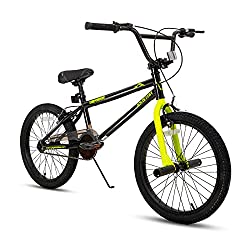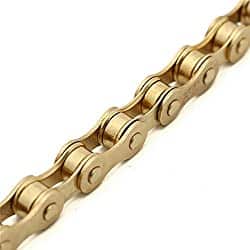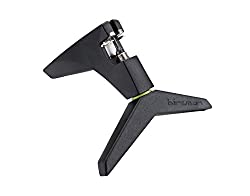Your BMX bike relies on its chain for propulsion. So, the chain has to fit right to work effectively, which brings us to this question: What size chain do I need for my BMX bike?
A standard BMX bike chain has an internal width of 1/8 inch, while thin and heavy-duty options measure 3/32 inch and 3/16 inch, respectively. Length-wise, standard BMX chains have 112, 98, or 96 links.
So, consider both the chain’s internal width and length.The apparent take would be to look at your old chain and use it to get the ideal size for the replacement.
On that note, I’ll share a quick BMX chain sizing guide to help you find a suitable chain replacement for your BMX.
But first, let’s look at the type of BMX bike chains that exist to determine what you have.

Types of BMX Bike Chains
Essentially, BMX bike chains come in two types as follows:
- Traditional BMX Chains – A traditional BMX bike chain employs similar inner and outer-link configurations as standard MTB and road bike chains. In that case, one chain features two half-links (one outer and one inner).
- Half-Link BMX Chain – Half-link BMX bike chains resemble traditional BMX chains and the other half narrower. That allows you to easily shorten them as you’ll only need to remove less material. It enables you to have a more precise chain size.
What Size Chain Do I Need For My BMX Bike?
When it comes to BMX chain sizes, we don’t emphasize its external width. We usually do that when dealing with multispeed and not single-speed, as it’s the case with BMX bikes.
So, we focus on the internal width but other than that, we look at its length as you wouldn’t want a chain that’s too loose or too tight.
Here are the sizes:
(i) Internal width
The standard chain’s internal width is 1/8 inch. We, however, have some non-standard BMX chain sizes that may be narrower or thicker than 1/8 inch.
Narrower BMX chains usually measure 3/32 inches and generally suit BMX race bikes. These chains save on weight, allowing you to go faster.
In contrast, heavy-duty BMX chains measure up to 3/16 inches. Such chains are best for heavy riders. Note, however, that most BMX bike chains have the standard internal width (1/8 inches).
(ii) Chain length
Standard BMX chains are measured in terms of links which include 112, 98, and 96 links. So, you’ll need to know how many links your old chain has to get a perfect replacement.
Alternatively, you can manually measure the chain length. Let’s see how you can do it.

How Do You Size A BMX Chain?
You can size your BMX chain length in any of these ways:
a) Count the Chain Links (when you have the old chain with you)
If your old BMX bike chain is there with you, you can count its number of links to determine what to get as its replacement.
To do this, you need to:
Step 1 – Check the size of the old chain
Ensure no links are missing on the old chain. You can do that by engaging the smallest sprocket to see if the chain fits well. If it doesn’t, then there’s something wrong with the chain.
Also, try engaging the largest sprocket. If there is no issue, then your chain length is okay. You can then proceed to step 2.
Step 2 – Take off the chain
It’s essential that you get the correct chain measurement, and to do that, you should remove the chain and manually count the number of links on it. Remember, the standard chain has 112, 98, or 96 links.
If manual counting of the chain links looks like much work, proceed to step 3.
Step 3 – Use Master Link
If you have a replacement BMX bike chain with you, align it with the old chain and insert the chain master link to help you properly align them according to the rivets. That’ll help you know how much of the new chain you need.

b) Calculate The Chain Size (if the old chain is absent or unreliable)
You can also calculate the chain size instead of counting the links. Here’s the formula to use:
Chain Length = (2 x C) + (/4 + r/4 + 1)
Where;
C stands for chainstay length, F for the number of teeth on the largest front cog, and R for the number of teeth on the largest rear cog.
So, you’ll need to identify the number of teeth on your chainring/cog to calculate the chain length using this formula.
Another important note is that this method is best when your old chain is nonexistent or too worn out to give you an accurate replacement size.
How Do You Tell You Need a New BMX Chain Size?
You can tell that you need a new BMX chain using any of these ideas:
- Check for chain skipping
If your bike chain is old, it’ll likely stretch, thus not fitting well on the chainring. As a result, it will start skipping when you engage it.
Generally, chain skipping is a sign of chain wear, and its solution is to replace it.
- Measure the chain link
This again brings us to the method we discussed earlier. Remember, a standard BMX chain should have 112, 98, or 96 chain links. Anything less than that shows a missing link.
- Use a chain wear checker
Nowadays, you can use so many tools to check for chain wear. These tools will show you the chain stretch percentage (which indicates chain wear).
One such tool to use on your BMX chain is the Park Tool Chain Checker. This chain checker will show you if the chain is stretched. Not only can you use it on single-speed chains but also multispeed options.
Overall, your BMX bike chain needs replacing if it indicates a stretch percentage of more than 1%.

- Measure the length between 12 links
Though this approach is less accurate, you can use it to determine if your bike chain is shorter or longer than usual. You’ll need to measure in inches the distance between 12 links.
If it’s 12 inches, the bike chain is of the correct length.
But once the length between the 12 links is more than 12 & 1/8 inches, you have a stretched chain that you should replace.
How Do You Fit A BMX Chain?
You cannot remove your new BMX chain from its box and expect it to fit perfectly. The chances are that it won’t, which means you have to resize it, and here are the steps to do it:
- Align the replacement parallel to the old chain (assuming the old chain is the correct length
- Insert a rivet through the end of the BMX chain that you don’t plan to cut
- Match the skewers of both chains to identify the point to cut the new chain
- Use a chain tool to cut the chain to size

People Also Ask
1. What Size BMX Chain Do I Need?
You can know what BMX bike chain size you need by counting the links on your old chain. A standard BMX length features a set of 112, 98, or 96 links. You can then use the values to get a replacement bike chain.
Also, ensure you get the inner width correctly. While standard chains measure 1/8-inch-wide, narrower options measure 3/16 inches while thicker ones measure 3/32 inches.
2. What Size Is A BMX Chain?
A standard BMX chain measure 1/8-inch-wide (inner width) and has a length equivalent to 112, 98, or 96 links. Non-standard chains, however, measure 3/32 or 3/16 inches wide.
3. How Do I Choose A BMX Chain?
Choosing the correct BMX chain depends on getting two things right; chain type and chain size. We have the traditional and half-link BMX chain when it comes to BMX chain types.
And when it comes to the chain size, standard chain lengths include 112, 98, and 96 chain links. So, you’ll need to count the links of your old chain and get a replacement with the same number of links or more and cut it to size.
4. How Long Should A BMX Chain Be?
BMX lengths are measured in terms of links, where the standard chain has 112, 98, or 96 links, depending on the manufacturer. You’ve to calculate the number of chain links on your existing chain to find a suitable replacement.
Also Read:
What Size Chain Do I Need for My BMX Bike? Closing Thought:
Generally, standard lengths for BMX chains are equivalent to 112, 98, or 96 links. Anything out of that range is not standard, which means you may have to cut the chain to size.
Don’t forget to consider the inner width, too, as it should be a 1/8 inch for the standard chain, 3/16 inch for the heavy-duty option, or 3/32 for slimmer ones.